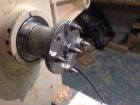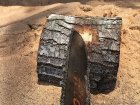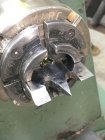So I came across this huge dry round of walnut at my buddy's yard sale, it was probably about 14 by 6 1/2 in maximum overall dimension. And he only wanted $5 for it, which may have had something to do with it's having a big ol' nail in it. I figured for 5 bucks, I'd take it.
Got it home and was able to excavate and extract the nail with a Dremel, grinding burr and pincers. Now I was faced with how to face off what were very very irregular ends and bring it round to being round, as well.
The first side had the remnants of an oblique chainsaw kerf that left a very large and deep overhanging cliff of wood that was never going to turn off safely, even if it could have been mounted. So my first thought was to saw off the overhang and then plane back the cliff into a slope thinking that with the "gentle" slope I could turn it flat and it would be no more than "jumping a curb". Unfortunately I didn't think to take any pictures until I had finished, but here you can see the large "cliff" that was sawn off and the gentle sloping curb that was left after planing.


Curb? Yeah, that's going to be more like jumping a Jersey Barricade. Especially since with the imbalance I would only be able to turn this at 300 RPM or so. Time for a plan B.
I cast around a bit for an idea and it came to me to use a large Forstner bit on the drill press with repeated overlapping operations to create a flatter if not actually flat surface.
Here is the block sitting on a plywood skid with shims to level it. The drill press depth stop has been set about a 1/4' above the bottom of the lowest "gully" reflecting that the center pin of the bit is about 1/4" tall.

The first picture as after the first few runs and the next further in progress.


Clamps were necessary and the Forstner does not like a lot of overlap and it really has to engage the center pin into the wood first or it doesn't work and play well. Here's a picture of the end result.

You can drill off the "stumps" if you can lead with the center pin, but at a certain point it was just easier to use a small flat saw or chisel.

Got it home and was able to excavate and extract the nail with a Dremel, grinding burr and pincers. Now I was faced with how to face off what were very very irregular ends and bring it round to being round, as well.
The first side had the remnants of an oblique chainsaw kerf that left a very large and deep overhanging cliff of wood that was never going to turn off safely, even if it could have been mounted. So my first thought was to saw off the overhang and then plane back the cliff into a slope thinking that with the "gentle" slope I could turn it flat and it would be no more than "jumping a curb". Unfortunately I didn't think to take any pictures until I had finished, but here you can see the large "cliff" that was sawn off and the gentle sloping curb that was left after planing.


Curb? Yeah, that's going to be more like jumping a Jersey Barricade. Especially since with the imbalance I would only be able to turn this at 300 RPM or so. Time for a plan B.
I cast around a bit for an idea and it came to me to use a large Forstner bit on the drill press with repeated overlapping operations to create a flatter if not actually flat surface.
Here is the block sitting on a plywood skid with shims to level it. The drill press depth stop has been set about a 1/4' above the bottom of the lowest "gully" reflecting that the center pin of the bit is about 1/4" tall.

The first picture as after the first few runs and the next further in progress.


Clamps were necessary and the Forstner does not like a lot of overlap and it really has to engage the center pin into the wood first or it doesn't work and play well. Here's a picture of the end result.

You can drill off the "stumps" if you can lead with the center pin, but at a certain point it was just easier to use a small flat saw or chisel.





